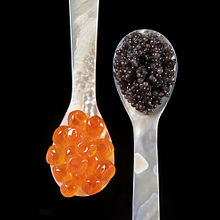
Back Kaviaar Afrikaans كافيار Arabic الكافيار ARZ Kürü Azerbaijani خاویار AZB Ікра ў кулінарыі Byelorussian Черен хайвер Bulgarian Caviar Catalan Ӏаьржа Ӏов CE Kaviár Czech
 Salmon roe (left) and sturgeon caviar (right) served with mother of pearl caviar spoons to avoid tainting the taste of the caviar. | |
| Place of origin | Iran (Persia) and/or Russia |
|---|---|
| Region or state | Black Sea region, Sea of Azov region, Caspian Sea region |

Caviar (also known as caviare, originally from the Persian: خاویار, romanized: khâvyâr, lit. 'egg-bearing') is a food consisting of salt-cured roe of the family Acipenseridae. Caviar is considered a delicacy and is eaten as a garnish or spread.[1] Traditionally, the term caviar refers only to roe from wild sturgeon in the Caspian Sea and Black Sea[2] (beluga, ossetra and sevruga caviars). The term caviar can also describe the roe of other species of sturgeon or other fish such as paddlefish, salmon, steelhead, trout, lumpfish, whitefish,[3] or carp.[4]
The roe can be "fresh" (non-pasteurized) or pasteurized, which reduces its culinary and economic value.[5]
- ^ Goldstein, D. (1999). A Taste of Russia: A Cookbook of Russian Hospitality. Russian Life Books. p. 71. ISBN 978-1-880100-42-4. Retrieved 28 May 2017.
- ^ lan Davidson, Tom Jane, The Oxford companion to food, Oxford University Press, 2006, ISBN 0-19-280681-5, ISBN 978-0-19-280681-9, p. 150.
- ^ "Smith Bros. Whitefish Caviar". web44.net. Archived from the original on 4 January 2014.
- ^ Fodor, Alexandrina, et al. "ASSESSMENT OF DEGREE OF FRESHNESS AND QUALITY OF PRODUCTS TYPE "FISH ROE" SOLD IN SUPERMARKET CHAIN STORES." Analele Universităţii din Oradea, Fascicula: Ecotoxicologie, Zootehnie şi Tehnologii de Industrie Alimentară 10.A (2011): 177–181.
- ^ According to Jean-Pierre Esmilaire, Directeur Général of Caviar House & Prunier: "two-thirds of caviar's taste is lost through pasteurisation." (in "Three-star caviar", Caterersearch – The complete information source for hospitality, 1 February 2001).